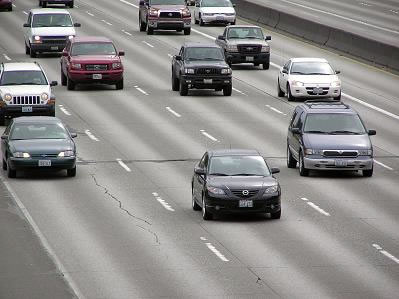Everybody loves driving on a freshly paved road in good condition. Wouldn’t it be great if those pavements never transformed into the crack and pothole filled roads we know all too well? As our pavement network grows older, the focus of road construction has shifted from the construction of new pavements to the maintenance, rehabilitation, and replacement of existing ones. This has led to an interest in how asphalt pavements can be designed to last longer to reduce the massive costs of upkeep. Perpetual pavements, or long lasting pavements that require minimal maintenance, have emerged as the fountain of youth for our transportation infrastructure.
 Can we make asphalt pavements that never grow old?
Can we make asphalt pavements that never grow old?What is a Perpetual Pavement?
Perpetual pavements refer to a class of asphalt pavements designed with enhanced longevity in mind. Though they don’t quite last forever, perpetual pavements are defined as those designed to last upwards of 50 years without structural rehabilitation. Rehabilitation of the surface course, or top-most layer of asphalt, is still performed throughout the life of the pavement (even Peter Pan needs new shoes from time to time). Despite their increased thickness, such designs have significantly reduced lifecycle costs when compared to traditional pavements. Because surface layer maintenance can be performed without serious disruption to traffic, perpetual pavements also help decrease user delay costs. Finally, perpetual pavements are environmentally friendly as less virgin material is used in the long term.

Perpetual Pavement Design
Perpetual pavements are designed using different methodology than typical pavements. Standard pavement design practices are based on analysis of traffic loads that are expected for the roadway at present and throughout its design life (typically around 20 years). These are used to select the necessary thickness of the individual pavement layers. In practice, the loads from larger vehicles such as trucks and buses are the primary determinants of pavement cross section thickness, rather than passenger automobiles, as these larger vehicles are responsible for the bulk of deterioration to the pavement structure. In contrast, perpetual pavement designs recognize the fact that once a pavement reaches a certain depth and corresponding structural strength, damage caused to layers below the surface by the largest categories of vehicles becomes essentially negligible. While perpetual pavements will show distress over time, these distresses are designed to be limited to rutting and cracking in the top layer of asphalt. This allows the pavement to be rehabilitated through a simple milling and overlay process.
By nature of the conservative design process for standard asphalt pavement cross sections, many existing roadway structures can already be classified as perpetual pavements. This is because traditional design does not identify the point of structural strength where vehicle loads will no longer impart permanent damage on the pavement. In some cases, designing for a perpetual pavement actually calls for smaller sections than standard designs that are over-conservative.
 The functional layers of a typical perpetual pavement design
The functional layers of a typical perpetual pavement designLayers in Perpetual Pavement
Perpetual pavements typically consist of three distinct asphalt layers. The top layer, also known as the surface or wearing course, is a standard high quality asphalt course that should primarily resist cracking and rutting. This can be a standard hot mix, warm mix, stone matrix asphalt, or an open graded course between 1.5 and 3 inches deep. The second layer of pavement will be responsible for supporting the bulk of the traffic load. This layer should be between 4 and 7 inches deep, consist of a high modulus and be extremely rut resistant. Finally, the lowest layer of the pavement will experience primarily tensile loads. This is because point loads from vehicle tires are distributed outward as they propagate through the pavement. As a result, this asphalt should be flexible and fatigue resistant. Typically, this flexible asphalt pavement is produced by using a high asphalt binder content. This layer can range anywhere from 3 to 4 inches in thickness.
 Perpetual pavement wearing courses can be replaced when traffic is minimal
Perpetual pavement wearing courses can be replaced when traffic is minimalPerpetual Pavement Maintenance
Realizing the full potential of the perpetual pavement structure requires proper maintenance of the surface layer. Distresses, particularly top-down cracking, are expected to occur in the top layer, and cannot be allowed to propagate into lower layers of the structure. This means that scheduling of milling and overlay activities has important consequences to the pavement’s overall performance. The enduring nature of the structural sections of perpetual pavements allows maintenance to be performed with little disruption of traffic. Generally, milling and overlay of a pavement section can be performed overnight.
Taking proper care of the wearing course of a perpetual pavement will allow it to keep functioning like new, reducing the costs of rehabilitation and use of materials. As intentionally designed perpetual pavements are a relatively new concept, we have yet to see the upper limit of how long these structures can last in practice. In any case, borrowing a page from the Neverland Department of Transportation Standard Specifications is a step in the right direction towards efficient, long lasting paving networks.


Perpetual Pavement Design seems to be important. Could you provide details of its design in the future news letters